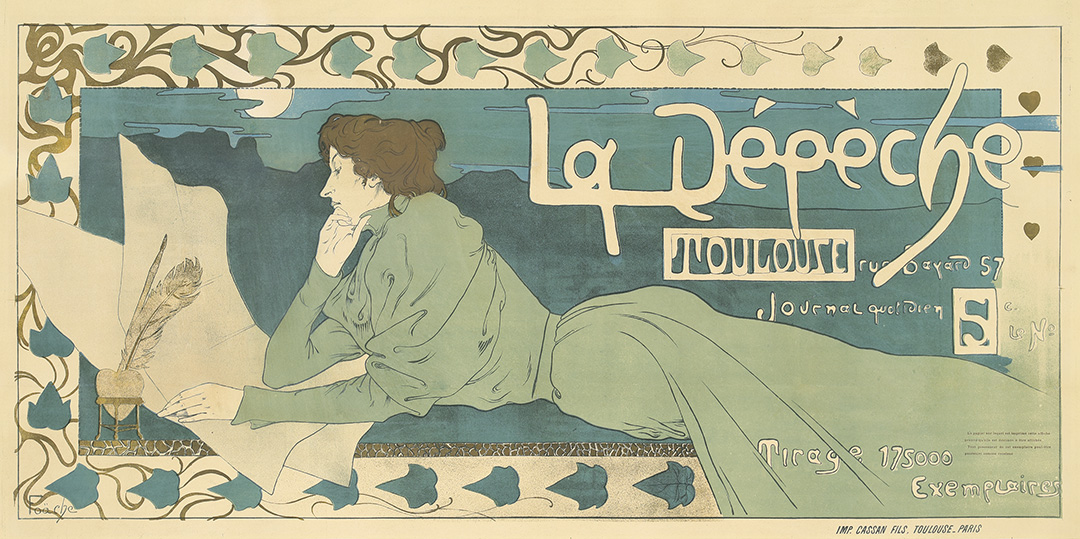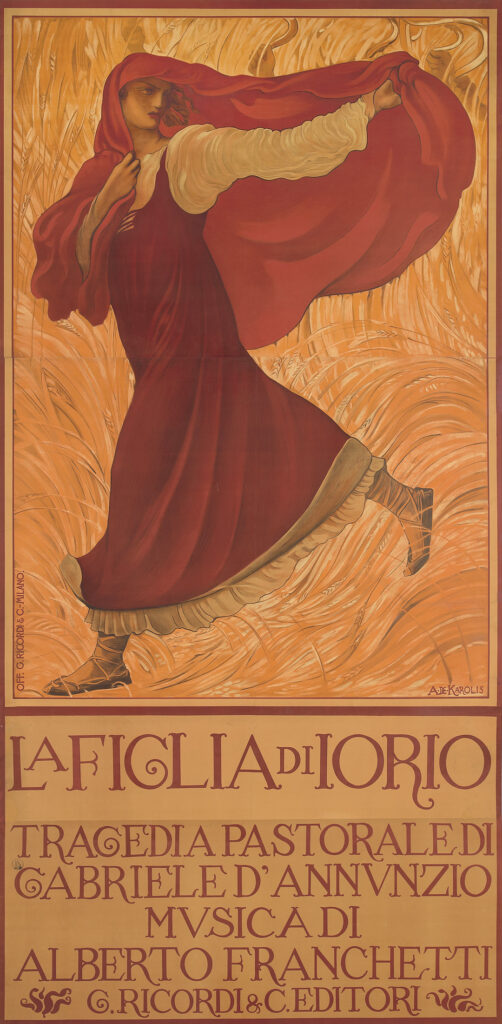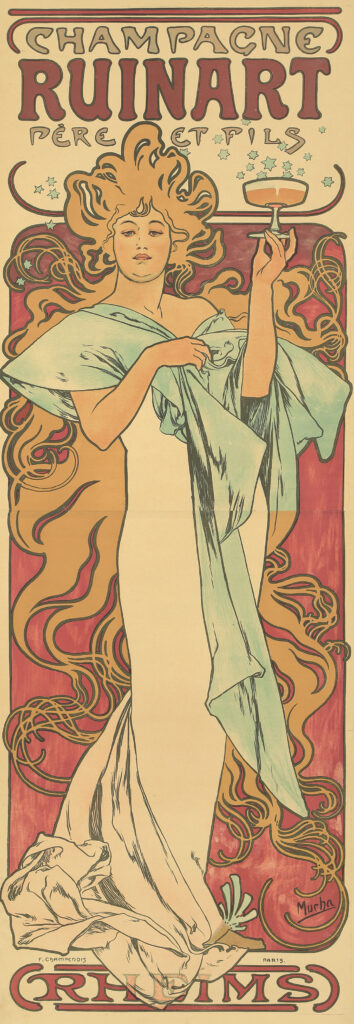Lush decorative designs exemplify the tenets of Art Nouveau: curvilinear forms, organic patterns, and romantic muses which celebrate beauty in its highest form. Our 90th auction includes masterful works from de Castille, Grün, Livemont, Mucha, Steinlen, and more.
By Albert Castille
Est: $10,000-$12,000
The golden bee (L’Abeille d’Or) is the motif of this extraordinarily sensuous design for the roasted coffee (Cafés Torréfiés) manufactured by the Adolphe Huybrechts firm of Antwerp. A medley of European Art Nouveau and Japonisme aesthetics, Castille borrowed the luxurious plumes of smoke from Livemont’s Absinthe Robette, the classic halo of Mucha, and a traditional silk kimono from Japan—and yet the overall image is a unique Castille concoction. Little is known of the French artist aside from the fact that he frequented his friend Livemont’s studio (see Livemont, p. 24). Rare!
By Georges de Feure (1868-1943)
Est: $10,000-$12,000
This poster for the Belgian Journal of the Auctions was immediately seized upon by contemporary critics and hailed as one of the finest works of its kind. Years later, Jane Abdy had the last and best word on it: “de Feure’s finest poster, and one of the most beautiful of the whole period… It is a triumph of color and design. He uses only brown, green and the dull pink of roses. Yet every possible shade of brown is in the poster, and the effect is a great richness and concentration of colour, like a mountain of brushed up autumn leaves… She is dressed in the height of imaginative fashion, and her hat is a victory of the milliner’s art” (p. 156). This is the rare variant before the addition of text.
By Arthur Foache (1871-1967)
Est: $3,000-$4,000
Green in several shades is the dominant color, with only the woman’s brown hair and tiny patches of blue in the background for contrast—yet somehow it all works, with the languid lady idly perusing the advertised paper serving as a magnet for our attention. Interestingly, The Poster of October, 1899, wasn’t entirely pleased with this work: “Foache’s poster for ‘La Dépèche’ is not so happy in conception, but is noted principally for being mainly a harmony of greens. We should have liked to have seen a more cheerful face on the reader of ‘La Dépèche.’ The artist is well known in the South of France, and we shall look to him to produce even better work than that under review” (p. 79). Be that as it may, we think it’s lovely.
By Jules-Alexandre Grün (1868-1938)
Est: $5,000-$6,000
In one of Grün’s rarest and most glorious designs, we see an overjoyed female spectator clad in sunshine yellow wave her lace handkerchief at the competing motor boats below. The perspective and composition of this poster outdoes almost everything else Grün produced—it is as close to lithographic perfection as one can achieve.
By Ludwig Hohlwein (1874-1949)
Est: $2,000-$2,500
Hohlwein is Germany’s preeminent posterist and surely ranks among the best internationally. His more than one thousand posters were distinguished contributions which made German Gebrauchsgrafik (commercial art) a leading force of poster design in the 1920s and ‘30s. “His special way of applying colors, letting them dry at different times, and printing one on top of the other, producing modulations of shading, has often been copied, but never equaled. He belonged to no school or group, [and] his art and personality are an unprecedented phenomenon in the history of German poster art” (Rademacher, p. 22). This design for St. Paul, the “quality cigarette,” is a splendid example of this color layering, with the gentleman in evening attire standing out in sharp contrast to and warmed by the vibrant colors of the background, which contains the presence of an admiring onlooker. Rare!
By Adolfo de Karolis (1874-1928)
Est: $7,000-$9,000
The peasant girl running through a field of golden grain is Mila, the title heroine of this ominous opera, who is escaping from some harvesters who want to rape her. When she does find refuge, it’s in the house of a man about to be married; she seduces him, and the rest of the opera deals with the tragic consequences of the act. This advertises the libretto of The Daughter of Iorio published by Ricordi. This is a three-sheet poster and rare!
By Privat Livemont (1861-1936)
Est: $8,000-$10,000
“To praise a gas burner, Livemont proceeds in a different way than in the poster for the Bec Auer. It is the naked female model, covered with a fine transparent veil, which is used here, with its procession of garlands of roses… The slogan ‘Le Bec Liais dethrones electricity’ confirms the fierce competition between electricity and gas lighting. It is no longer a woman-candelabra that is offered here to the spectator’s gaze, but a woman in the privacy of her toilet. A certain naturalistic classicism has joined Art Nouveau, especially in the design of the foliage” (Livemont, p. 125). This printing before the addition of text is rare!
By Alphonse Mucha (1860-1939)
Est: $17,000-$20,000
In 1729, Nicolas Ruinart decided to start a champagne company, much like that of his uncle’s dear friend Dom Pérignon. It remained a family business out of Reims until it was taken over by the Baron Philippe de Rothschild in 1950, and then again by Moët & Chandon in 1963. It remains one of the largest champagne houses in Europe. In this brilliant design by Mucha, “the lady’s face appears to be in perfect repose, and the hand holding the glass seems steady; but her hair betrays her, scampering off in wild abandon and thus conveying the notion of the effervescent effect of the champagne. Here, the hair actually has the function of subtly conveying a quality of the product, a rather novel use of a physical attribute in advertising in its day” (Rennert/Weill, p. 86). This is a two-sheet poster.
By Joseph Maria Olbrich (1867-1908)
Est: $5,000-$6,000
Olbrich had his hands in everything related to the art world in turn-of-the-century Germany and Austria; an architect and graphic designer, he co-founded the Viennese Secession group, founded the Darmstadt Kunstler Kolonie, and helped organize the Cologne art exhibition for which he designed this ornate poster. Held at the Cologne Botanical Gardens, the exhibition included various forms of media, from paintings to jewelry to metalworking. His image employs graphic rigidity and floral ornamentation that mixes German precision with a touch of flourishing Art Nouveau.
By Walter Schnackenberg (1880-1961)
Est: $25,000-$30,000
Provenance: The Karl Lagerfeld Collection
In the period leading up to World War I, Berliners danced as fast and as hard as they could. Hotel ballrooms were grand places to fox-trot the night away and dance teams were very much in demand as nightclub performers. Despite the memorable name of this twosome (who Schnackenberg smartly depicts in brown rather than the usual black), no information about them survives. The design bears a strong resemblance to the artist’s Odeon Casino (see prior lot) and this work, created in the same year, very well may have been a brilliant study for the more styled, decadent poster yet to come (see Peter Pathe / Maria Hagen, PAI-LXXXV, 428).
By Théophile-Alexandre Steinlen (1859-1923)
Est: $14,000-$17,000
All the warmth, humanity, and affection for which Steinlen is so loved comes through gloriously in this poster for the newly marketed “lait stérilisé” that was touted over the “lait ordinaire” at that time. Charles Knowles Bolton, writing a year after its publication, proclaimed that this “is perhaps the most attractive poster ever made. No man with half a heart could fail to fall in love with the child.” Louis Rhead himself commented: “When I saw it in Paris last year… it seemed to me the best and brightest form of advertising that had appeared.” This is the medium format version.
By Fernand Toussaint (1873-1955)
Est: $12,000-$15,000
Le Sillon was a magazine, as well as an artistic and religious movement, to emphasize the communal and nurturing aspects of Christianity. It was a philosophy founded by Marc Sangnier (1873-1950), and was influential from 1894 to 1910. The title means “The Plow” or “The Furrow,” derived from the phrase “cruser son sillon”: to plow one’s own furrow, or to make one’s own way in the world. For Toussaint’s first poster, the artist seizes upon this ideal, showing a dreamy blonde at the annual grain harvest, gathering both the fruits of the field and the fruits of this group’s work. As ethereal and magical as it is graphically complex, this design is a tour de force.
In-gallery viewing June 29 – July 17 (11am-6pm daily)












